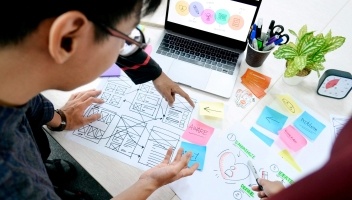The Human Empathy Project: amplifying the voices of everyday Americans

In the United States where headlines dominate the media, it makes you wonder if the polarizing, clickbait-type stories are truly the opinions of the majority. This is a concept that Mike Mace, VP of Market Strategy at UserTesting, wanted to understand better. In this Q&A, discover his motivation and intention for his latest passion project: The Human Empathy Project.
How The Human Empathy Project got its start
Tell us about your current role at UserTesting leading market strategy, and how it might have influenced your passion for the Human Empathy Project.
The thing that drew me to UserTesting was the way it empowers people to much more easily get feedback. Back when I started my career, market research was very slow and complicated. If you wanted to do a survey, you had to plan it out manually and hire a company to call people on the phone and ask them questions. It took months. And getting spoken feedback meant scheduling focus groups and flying all over the country. Again, very slow and time-consuming. The changes we’ve made to that situation in the last ten years are a genuine revolution.
Now you can get feedback in less than a day, on almost anything. So several of us at UserTesting, and our own customers as well, started to wonder if we could use the system to get feedback on things that weren’t just about usability. Things like customer needs and attitudes. It’s part of my job to identify new market opportunities for the company, so it was pretty natural to ask, “could we also use our system to get feedback on important public issues? Would the participants be willing to talk on camera about those things?”
It turns out they are comfortable, and they have a lot to say.
The Human Empathy Project’s mission
Who’s the intended reader for The Human Empathy Project?
Anyone who wants to understand the country better. We’re trying to help Americans get to know each other, so we can solve problems together. Anyone is welcome.
What’s the goal of The Human Empathy Project?
We want to amplify the voices of normal people. Today most of us are getting out-shouted by a small percentage of very strident, polarized people, on both extremes of the political spectrum, who don’t represent the average American. It makes us all think that we’re far more angry and divided than we actually are. We’re trying to push back on that by giving regular folks a voice.
Do you have any expected outcomes for the project?
We don’t have any illusions about what a single website can do, but over time we’d like to help people in the country become a little bit more cooperative and empathetic toward each other. We’re really not as divided as we think we are—and even where we disagree, there’s usually room for compromise or at least respect. We’d like to help everybody see that.
Choosing the right participants for The Human Empathy Project
How do you choose the participants for your studies?
At random. That’s the whole point of it. Occasionally we’ll use demographic filters to make sure we get a balanced sample of the country, but other than that it’s first come, first served.
Could you share a breakdown of the demographics and geographic locations of the participants for your studies thus far?
They are spread all over the country, in all age, income, and racial groups. You need to have a smartphone to participate, so we can’t reach every single person in the country, but most people have smartphones these days, so it’s pretty representative.
How many people do you test with for each study?
It varies, but usually a few dozen. We try to pair the studies with quantitative surveys, so we know that the videos we’re showing really represent average people and not an outlier.
Collecting insight for The Human Empathy Project
What method(s) do you use to collect the insights that give you the perspectives you write about? How do you screen to ensure you’re truly capturing the average American’s voice?
We use the UserTesting Human Insight Platform to have people interview themselves. They read the questions, look at their smartphone or computer camera, and answer. Since there’s no one else online with them, they open up quite a bit on their thoughts and feelings. It’s surprisingly personal
What are some topics you hope to address in future posts for The Human Empathy Project?
The election and pandemic are obvious ones, but we’d also like to dig into other important issues where there’s controversy or we suspect regular people aren’t being heard. Everything from global warming to the way that many rural people in the US feel marginalized and mistreated. We’re trying very hard to be balanced politically. We’re equally interested in issues that matter to conservatives and liberals.
Tell us about a time when you received a strong emotional reaction within one of your studies. Were you surprised by it? Did it invoke a different point of view you otherwise wouldn’t have considered?
For me, one of the most touching results so far was the reaction when we asked people if they had anything they wanted to say to the rest of the country. There were differing agendas, of course, but mostly there was this huge desire for empathy and civility in the country—from people across the political spectrum. We really do have these terrible, inaccurate stereotypes of one another, and they keep us apart.
Do you have any guidelines or recommendations for getting honest feedback from people on potentially sensitive topics?
You have to give them a safe space to answer. Be totally transparent about who you are, how you’ll use the information, and what your agenda is. And let them opt-out if they aren’t comfortable. For a really sensitive topic (for example, racial justice) we’d give them the option of having their faces blurred. The thing is, most people really want to share their views, but they are afraid of being attacked online. You have to protect them from that.
Putting insights into action
How can people and organizations apply the insights that you provide in their own work? Do you have any examples of how people have used your insights? Suggestions for leveraging the insights?
We just got started, so I don’t have examples yet of how we’re being used. But the information we’re finding is useful to any organization that’s dealing with the public because it tells you how regular people are feeling. It’s great context for your planning, and it will give you ideas on how to engage with others.
Frankly, it’s also in the interest of everybody to share this information, simply in order to help make the country a calmer, saner place. We’ll all be able to live a little easier when we understand that there’s ground for compromise and cooperation.
Get involved
Can people contribute their own articles to The Human Empathy Project? What sort of submissions are accepted?
We’d absolutely love to get outside contributions. We’d also like to partner with people doing other forms of research on these issues (for example, organizations doing surveys that could be supplemented by our videos). Please contact us at humanempathyproject@gmail.com.
Insights that drive innovation
Get our best human insight resources delivered right to your inbox every month. As a bonus, we'll send you our latest industry report: When business is human, insights drive innovation.






